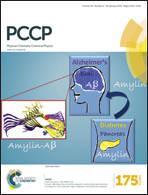Urea hydration from dielectric relaxation spectroscopy: old findings confirmed, new insights gained†
Abstract
We report results on urea hydration obtained by dielectric relaxation spectroscopy (DRS) in a broad range of concentrations and temperatures. In particular, the effective hydration number and dipole moment of urea have been determined. The observed changes with composition and temperature were found to be insignificant and mainly caused by the changing number density of urea. Similarly, solute reorientation scaled simply with viscosity. In contrast, we find that water reorientation undergoes substantial changes in the presence of urea, resulting in two water fractions. The first corresponds to water molecules strongly bound to urea. These solvent molecules follow the reorientational dynamics of the solute. The second fraction exhibits only a minor increase of its relaxation time (in comparison with pure water) which is not linked to solution viscosity. Its activation energy decreases significantly with urea concentration, indicating a marked decrease of the number of H-bonds among the H2O molecules belonging to this fraction. Noncovalent interactions (NCI) analysis, capable to estimate the strength of the interactions within a cluster, shows that bound water molecules are most probably double-hydrogen bonded to urea via the oxygen atom of the carbonyl group and a cis-hydrogen atom. Due to the increased H-bond strength compared to the water dimer and the rigid position in the formed complex the reorientation of these bound H2O molecules is strongly impeded.


 Please wait while we load your content...
Please wait while we load your content...